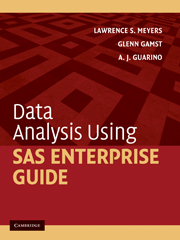Book contents
- Frontmatter
- Contents
- Preface
- Acknowledgments
- I Introducing SAS Enterprise Guide
- 1 SAS Enterprise Guide Projects
- 2 Placing Data into SAS Enterprise Guide Projects
- II Performing Analyses and Viewing Output
- III Manipulating Data
- IV Describing Data
- V Score Distribution Assumptions
- VI Correlation and Prediction
- VII Comparing Means: The t Test
- VIII Comparing Means: ANOVA
- IX Nonparametric Procedures
- X Advanced ANOVA Techniques
- XI Analysis of Structure
- References
- Author Index
- Subject Index
1 - SAS Enterprise Guide Projects
Published online by Cambridge University Press: 05 June 2012
- Frontmatter
- Contents
- Preface
- Acknowledgments
- I Introducing SAS Enterprise Guide
- 1 SAS Enterprise Guide Projects
- 2 Placing Data into SAS Enterprise Guide Projects
- II Performing Analyses and Viewing Output
- III Manipulating Data
- IV Describing Data
- V Score Distribution Assumptions
- VI Correlation and Prediction
- VII Comparing Means: The t Test
- VIII Comparing Means: ANOVA
- IX Nonparametric Procedures
- X Advanced ANOVA Techniques
- XI Analysis of Structure
- References
- Author Index
- Subject Index
Summary
A brief history of SAS
The SAS Web site provides a comprehensive history of the software and the company. Here is a synopsis of that information. SAS, an acronym for Statistical Analysis Software, is a set of statistical analysis procedures housed together within a large application. The idea for it was conceived by Anthony J. Barr, a graduate student at North Carolina State University, between 1962 and 1964. Barr collaborated with Jim Goodnight in 1968 to integrate regression and analysis of variance (ANOVA) procedures into the software. The project received a major boost in 1973 from the contribution of John P. Sall. Other participants in the early years of SAS development included Caroll G. Perkins, Jolayne W. Service, and Jane T. Helwig. The SAS Institute was established in Raleigh, NC in 1976 when the first base SAS material was released. The company moved to its present location of Cary, NC in 1980.
SAS began being used on mainframe computers several decades ago. At that time, the only way to instruct the software to perform the statistical analyses was by punching holes on computer cards via a card-reader machine. Later this instruction occurred by typing in this code on an otherwise blank screen. The majority of SAS users still prefer this latter process.
- Type
- Chapter
- Information
- Data Analysis Using SAS Enterprise Guide , pp. 3 - 12Publisher: Cambridge University PressPrint publication year: 2009



